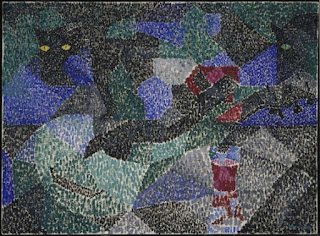Gino Severini: The Black Cat (1910-11)
Oil on canvas (54.4 x 73 cm)
Oil on canvas (54.4 x 73 cm)
Edgar Allan Poe's short story The Black Cat (1843) not only influenced many other writers, but also those working within the visual arts, including, for example, the Italian Futurist Gino Severini, whose painting above was included in the first Futurist exhibition, held in Paris, in 1912.
But perhaps the most interesting work drawing inspiration from Poe's disturbing tale of alcoholism, animal cruelty, and domestic violence, is the 1934 film, The Black Cat,* directed by Edgar G. Ulmer and starring Boris Karloff and Bela Lugosi (the first of eight films to pair the gruesome twosome).
Actually, despite listing Poe's name in the credits, Peter Ruric's screenplay (based on Ulmer's scenario) has no resemblance to the narrative events of Poe's story and the film gets its real inspiration from the life of Aleister Crowley, particularly Karloff's character, Hjalmer Poelzig, a mad Austrian architect with a penchant for chess and black cats, who comes to a grisly end shackled to an embalming rack and skinned alive.
Although it was a box office hit, the film didn't much impress the critics upon its original release, who mostly found it, in the words of one reviewer, more foolish than horrible.
However, Ulmer's movie is now recognised as a bizarre and stylish masterpiece; one that unfolds with the crazy logic of a nightmare and brilliantly develops the psychological horror genre with its creepy atmosphere, sinister soundtrack and an emphasis on the darker (more perverse) elements of the human psyche; including the propensity for incest, sacrifice, necrophilia, and devil worship.
Actually, despite listing Poe's name in the credits, Peter Ruric's screenplay (based on Ulmer's scenario) has no resemblance to the narrative events of Poe's story and the film gets its real inspiration from the life of Aleister Crowley, particularly Karloff's character, Hjalmer Poelzig, a mad Austrian architect with a penchant for chess and black cats, who comes to a grisly end shackled to an embalming rack and skinned alive.
Although it was a box office hit, the film didn't much impress the critics upon its original release, who mostly found it, in the words of one reviewer, more foolish than horrible.
However, Ulmer's movie is now recognised as a bizarre and stylish masterpiece; one that unfolds with the crazy logic of a nightmare and brilliantly develops the psychological horror genre with its creepy atmosphere, sinister soundtrack and an emphasis on the darker (more perverse) elements of the human psyche; including the propensity for incest, sacrifice, necrophilia, and devil worship.
Click here for the trailer
Notes
* Not to be confused with the 1941 film also entitled The Black Cat, dir. Albert S. Rogell and starring Basil Rathbone, which also claims to have been inspired by Poe's short story and also features Lugosi in a cameo role.
Readers might be interested in a sister post to this one, Reflections on a Black Cat (In Memory of Pluto): click here.
This post is for Anna, the Italian dental nurse.


No comments:
Post a Comment